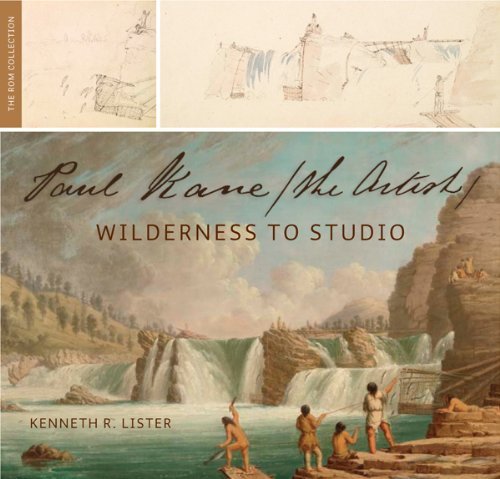| ________________
CM . . . . Volume XVII Number 40. . . .June 17, 2011. 
 |
Paul Kane/The Artist: Wilderness to Studio.
Kenneth R. Lister.
Toronto, ON: Royal Ontario Museum Press, 2011.
416 pp., hardcover, $75.00.
ISBN 978-0-88854-480-3.
Subject Headings:
Kane, Paul, 1810-1871.
Kane, Paul, 1810-1871-Criticism and interpretation.
Kane, Paul, 1810-1871-Family.
Painters-Canada-Biography.
Grades 8 and up / Ages 13 and up.
Review by Ann Stinner.
****/4
|
| |
|

excerpt:
Paul Kane/The Artist: Wilderness to Studio is a large, very comprehensive and elegantly produced book, published in 2010 by the Royal Ontario Museum Press to celebrate the 200th anniversary of Kane's birth. It is bound to delight all those readers in both the scholarly community and the general public who love Canadian art and history, aboriginal ethnography and fine book design. For the first time, the complete works of Paul Kane (1810 1871) have been assembled in one volume. The works include Kane's journal writings, sketches, paintings, and images of the related artifacts he collected on his travels, and they are supplemented by relevant maps and photographic material. These treasures, gathered from the Royal Ontario Museum and other sources, are accompanied by an insightful and very readable text by Kenneth R. Lister, Assistant Curator of Anthropology in the Department of World Cultures at the ROM, with contributions by others, such as Maude Cassels, daughter of Kane's principle patron, George William Allen; and Paul James Kane, great-great grandson of the artist. Together, the text and the images in this definitive study create as complete a picture as we have ever had of this important Canadian artist.
Although Kane was born in Ireland, he lived from childhood on in York (Toronto) and used that growing commercial and cultural centre as the base for his own artistic practice and his trips to some of the art centres of Europe. It was also the starting point for his two expeditions to western North America. His historic journeys across the continent (1845 and 1846-48) were conducted by canoe, bateau, horseback, snowshoe and dogsled, and took him through the Great Lakes region, across the prairie, over the Rocky Mountains and as far west as the mouth of the Columbia River and southern Vancouver Island. Despite the hardship of these expeditions, Kane created more than 600 sketches along the way, in graphite, watercolour and oil on paper, and they are all included here. He appears to have seen himself as a scientist/ethnographer and was determined to capture accurately, and in great detail, the landscapes he passed through, as well as the appearance and daily lives of the various native peoples he encountered. In a journal, Kane kept a written record of his travels, and extracts from this journal (complete with idiosyncratic spelling) accompany the sketches and maps.
The subtitle of this volume, Wilderness to Studio, suggests what happened next. The enthusiastic public response to Kane's western sketches and the support of benefactors encouraged him to embark on a series of larger studio produced oil paintings based on the original drawings. Kane eventually painted about 100 of these works which were much admired by his contemporaries. By comparing the sketches and Aboriginal artifacts with the final paintings, all reproduced in this book on facing pages, we have a chance to study Kane's creative process in detail and to consider whether or not, as some have claimed, Kane switched from being a scientist/ethnographer in his sketches to a painter of "imaginative truths" in the romantic style, influenced by European artistic conventions of the times. Being able to compare so conveniently for ourselves Kane's representations of his subject matter is a wonderful opportunity.
In addition to providing such a complete picture of Paul Kane, this volume also offers us physical beauty. The design of the book is very handsome, with the artwork and blocks of text on each page surrounded by ample white space. This layout makes close viewing and reading without distractions a pleasure. Furthermore, the technical reproduction of the images is remarkable, considering how delicate many of the sketches and watercolours are. Although the paintings are reproduced at approximately half a page in size, most of the 600 sketches are of necessity quite small. Happily, the endpapers feature an enlargement of one graphite and watercolour drawing, "Sketch on the Spokane" (1847) which shows us, close up, the fluidity and subtlety of Kane's on the spot sketching style.
Anyone who is interested in what life was like in western North America in the midnineteenth century will find Paul Kane/The Artist very rewarding. There are, for example, scenes of and journal entries about ? specific lakes, rivers and mountain regions, buffalo and other wild life, native camps and individual portraits of tribal leaders, early settlements like Fort Garry and Fort Edmonton, prairie fires and, further west, Mount St. Helen's volcano and Oregon City. Teachers and older history students will appreciate the detailed geographical and ethnographical information found in the images and captions, as well as the extensive reference list at the end of the book. General readers and younger students will enjoy dipping into an important and historic travelogue and comparing locations they know with Paul Kane's view of the same places just over 150 years ago. All readers will come away impressed with the diligence and artistry of this early Canadian icon.
Highly Recommended.
Ann Stinner is a Winnipeg, MB, book artist and a former art education instructor at the University of Manitoba.

To comment on this title or this review, send mail to
cm@umanitoba.ca.
Copyright © the Manitoba Library Association. Reproduction for personal use is permitted only if this copyright notice is maintained. Any other reproduction is prohibited without permission.
NEXT REVIEW |
TABLE OF CONTENTS FOR THIS ISSUE- June 17, 2011.
AUTHORS |
TITLES |
MEDIA REVIEWS |
PROFILES |
BACK ISSUES |
SEARCH |
CMARCHIVE |
HOME |
